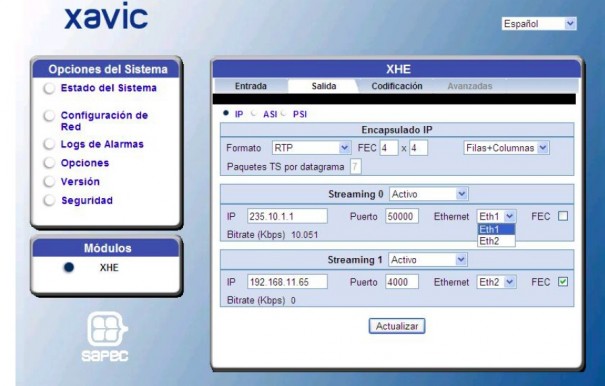Sapec will present encoders with H4:2:2P contribution profile for H.264 in SD and HD at NAB
With the implementation of this profile, the Xavic product range becomes a complete solution to cover the contribution and distribution needs of telecommunications operators and television networks, since they can perform compression in both H.264 and MPEG-2 with 4:2:0 and 4:2:2 profiles in standard definition (with analog and digital signals) and high definition.
Sapec will present at NAB 2011 in Las Vegas (USA) from April 11 to 14 its new models of the Xavic family, multi-format encoders and decoders (H.264/MPEG-2) in standard definition and high definition, with H4 contribution profile :2:2P for H.264 in SD and HD.
With the implementation of this profile, the Xavic product range becomes a complete solution to cover the contribution and distribution needs of telecommunications operators and television networks, since they can perform compression in both H.264 and MPEG-2 with 4:2:0 and 4:2:2 profiles in standard definition (with analog and digital signals) and high definition.
The models presented at the fair will include version 3.0 of the compression algorithms developed by Sapec, which allows reductions of 15% in bitrate for the same image quality. To this end, the possibility of taking B images (image obtained predictively with other previous and subsequent ones) has been incorporated as a reference for future predictive images. In addition, the transmission delay has been reduced: 10% in H.264 and 30% in MPEG-2.
Variable bitrate (VBR) encoding mode has also been introduced in H.264, allowing the encoding rate to be adjusted to the complexity of the images.
Another important improvement is the incorporation of three types of video pre-processing: temporal compensation (MCTF), configurable in five levels; spatial filtering, configurable in five levels; and frequency filtering
Each of these filters is selectable at the user's discretion, so that it is possible to apply one, two, three or none of the available types of pre-processing.
On the other hand, although Xavic equipment maintains perfect synchronization between audio and video, it is possible to compensate for delays present in the input signal introduced by external elements by making shifts in the encoder both in frames, up to a maximum of 3, and in time, in a range between -100 and +50 msec in steps of 1 msec.
The IP interface of Xavic equipment has been improved and is now resistant to networks with very high jitter (variation in the reception rate of IP packets). Said IP interface continues to have the already known characteristics of supporting two IP Video streams, multicast or unicast, which can be sent through each of the two available IP communications ports or both streams can be sent through only one of them.
Did you like this article?
Subscribe to our RSS feed and you won't miss anything.














